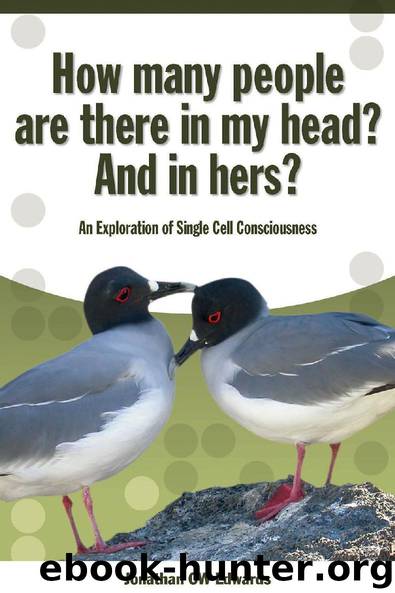How Many People Are There In My Head? And In Hers? by Jonathan C.W. Edwards

Author:Jonathan C.W. Edwards
Language: eng
Format: epub
Tags: Consciousness, mind-brain problem, conscious, single cell, biology, awareness, intercellular interaction
ISBN: 9781845407094
Publisher: Andrews UK Limited 2013
Published: 2013-07-23T00:00:00+00:00
Part III: If It Were So
Ten: Thinking Is More Than Awareness
While a theory is being constructed, its incomplete state of development often prevents its detailed experimental consequences from being assessed. Nevertheless [we] must make choices ... Some ... are dictated by internal logical consistency ... but ... some ... are founded on an aesthetic sense ...
Brian Greene (on superstring theory), The Elegant Universe, 2000
In discussing consciousness some people appear to use the word to mean awareness and some to mean thinking. The confusion leads to all sorts of problems. In early discussions about the idea of ‘consciousness’ belonging to cells individually I came across a number of people who made comments like ‘How could a single cell make all the necessary decisions?’ or ‘Why wouldn’t there be conflict between the actions of different cells? Many times I have needed to point out that I am not in the least suggesting that each cell can think separately. Thinking is a rolling narrative of sensations followed by actions which become themselves part of the next instant’s sensations which then are followed by more actions and so on. It is a series of events that must involve a net, or at least a chain of many, many cells. What I am suggesting is that each of these many cells has an enormously rich input about what is going on, and nothing in the brain has a richer input, but in terms of output, each cell is restricted to contributing only one in ten billion of the signals which determine the progress of thought. If we make an important decision every minute and one cell tips the balance of that decision the average brain cell will have this honour once every thirty thousand years. It is likely that many brain cells never determine an act throughout their entire life.
This is no more than what we know based on fact. Neurones have wonderfully rich inputs and only one output. The output may be sent to a thousand places but it, and the places it reaches, are always the same. As I indicated before, neurones can be viewed as like couch potatoes watching a video with a one button infra-red handset in their palm. Imagine the following scenario in the not too distant future. An interactive video is playing on a TV channel being watched by ten billion five year olds lying on their sofas. The viewers are told to press their buttons when they want something exciting to happen. The video is truly interactive in that there are a variety of options for the story and these are chosen on the basis of how many signals come back from the viewers at any one point in the story. The catch is that the children do not realise that anybody else has a handset as well, so each child at the end rushes out to say ‘mum, I made this video really exciting by pressing my handset, I did it all myself’.
Again, if you take away
Download
This site does not store any files on its server. We only index and link to content provided by other sites. Please contact the content providers to delete copyright contents if any and email us, we'll remove relevant links or contents immediately.
Rewire Your Anxious Brain by Catherine M. Pittman(18553)
Talking to Strangers by Malcolm Gladwell(13222)
The Art of Thinking Clearly by Rolf Dobelli(10223)
Mindhunter: Inside the FBI's Elite Serial Crime Unit by John E. Douglas & Mark Olshaker(9201)
Becoming Supernatural by Dr. Joe Dispenza(8119)
Change Your Questions, Change Your Life by Marilee Adams(7635)
Nudge - Improving Decisions about Health, Wealth, and Happiness by Thaler Sunstein(7615)
The Road Less Traveled by M. Scott Peck(7522)
The Lost Art of Listening by Michael P. Nichols(7408)
Enlightenment Now: The Case for Reason, Science, Humanism, and Progress by Steven Pinker(7235)
Mastermind: How to Think Like Sherlock Holmes by Maria Konnikova(7227)
Win Bigly by Scott Adams(7094)
The Way of Zen by Alan W. Watts(6506)
Daring Greatly by Brene Brown(6447)
Big Magic: Creative Living Beyond Fear by Elizabeth Gilbert(5614)
Grit by Angela Duckworth(5523)
Ego Is the Enemy by Ryan Holiday(5294)
Men In Love by Nancy Friday(5156)
Altered Sensations by David Pantalony(5045)
